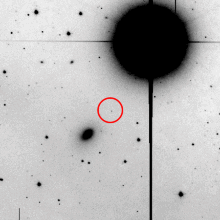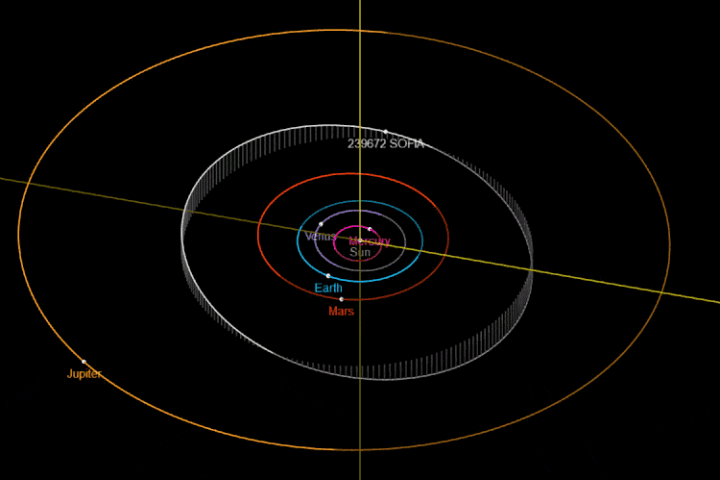This is a great honor for SOFIA, the Stratospheric Observatory for Infrared Astronomy, the scientific management of which takes place in Germany at the University of Stuttgart. The Minor Planet Center (MPC), part of the International Astronomical Union (IAU) in Cambridge/USA, announced that the asteroid with the number 239672 has now been named after the flying observatory.
The designation came from the initiative of Felix Hormuth, who discovered the asteroid during the night of December 21st, 2008 using the 1.23 m telescope at the Calar Alto Observatory. A time series of exposures revealed the object’s continuously changing position. Once the discovery had been confirmed, the MPC labeled the minor planet with the temporary designation "2008 YS1".
After numerous other observers had traced the position of the newly discovered minor planet over time, it received a permanent ID number. To assign a number, the MPC requires reported observations that span at least four opposition periods. During an opposition period, Earth laps the asteroid on its orbit around the Sun, allowing observations over a large fraction of the night. After accumulating observations over at least four of such orbital laps, the asteroid’s orbit can be calculated with sufficient precision to recover it in the future.
Once numbered, the discoverer has the privilege to propose a name within ten years, following various criteria. An international IAU committee of fifteen astronomers will then decide whether to accept the proposal or not. Back in October 2017, Felix Hormuth visited the Calar Alto Observatory once again, and met with Karsten Schindler of University of Stuttgart’s DSI (Deutsches SOFIA Institut) to observe a stellar occultation by Neptune’s moon Triton, simultaneously with SOFIA. That triggered the idea: "As SOFIA explores our solar system in a unique way, I feel it is well deserved to dedicate a namesake to this flying observatory, one that is a permanent outpost outside of Earth’s atmosphere", said Felix Hormuth.
(239672) SOFIA orbits the Sun in the outer Main Asteroid Belt of our solar system between Mars and Jupiter – a SOFIA year equals 4.81 terrestrial years. The exact size of the asteroid has not been measured yet. Assuming a spherical body with average reflectance, its diameter would be somewhere between 4.6 km (C-type asteroid with a darker, carbonaceous surface) and 1.8 km (S-type asteroid with a brighter, stone-like surface), depending on its geological and chemical composition. It is most likely, however, that (239672) SOFIA is rather an irregularly shaped body.
Due to the current position of the Earth relative to (239672) SOFIA, another observation of the minor planet will not be possible before fall of this year, when (239672) SOFIA will be visible again in the morning sky. Until then, the minor planet orbits behind the Sun as seen from Earth.
About SOFIA:
SOFIA, the "Stratospheric Observatory for Infrared Astronomy" is a joint project of the Deutsches Zentrum für Luft- und Raumfahrt e.V. (DLR; German Aerospace Center, grant: 50OK0901, 50OK1301 and 50OK1701) and the National Aeronautics and Space Administration (NASA). It is funded on behalf of DLR by the Federal Ministry for Economic Affairs and Energy based on legislation by the German Parliament, the State of Baden-Württemberg and the University of Stuttgart. Scientific operation for Germany is coordinated by the German SOFIA-Institute (DSI) of the University of Stuttgart, in the USA by the Universities Space Research Association (USRA).
Expert Contact:
Dr. Dörte Mehlert, University of Stuttgart, German SOFIA Institute, phone: +49 711 685-69632, email
Masiero et al. (2011), ApJ 741:68, doi:10.1088/0004-637X/741/2/68



